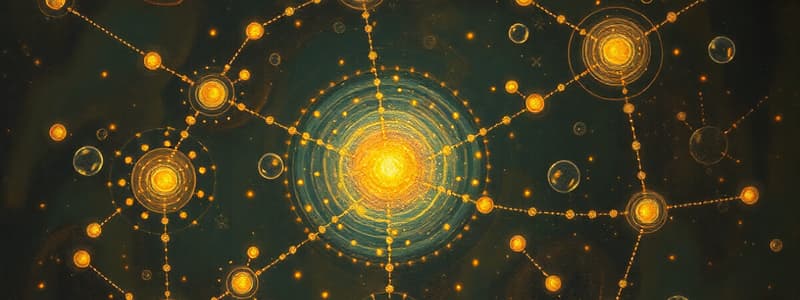Podcast
Questions and Answers
What usually happens when insulators are subjected to extreme conditions such as high heat or voltage?
What usually happens when insulators are subjected to extreme conditions such as high heat or voltage?
What is the relationship between an atom's number of valence electrons and its classification as an insulator, semiconductor, or conductor?
What is the relationship between an atom's number of valence electrons and its classification as an insulator, semiconductor, or conductor?
What happens to the conduction capability of materials like glass when they are heated?
What happens to the conduction capability of materials like glass when they are heated?
What does 'breaking down' refer to in insulating materials under extreme conditions?
What does 'breaking down' refer to in insulating materials under extreme conditions?
Why is it important for manufacturers to quote safe working limits for insulating materials?
Why is it important for manufacturers to quote safe working limits for insulating materials?
What happens to an atom when it loses electrons?
What happens to an atom when it loses electrons?
Which type of ion is formed when an atom gains electrons?
Which type of ion is formed when an atom gains electrons?
Which factor primarily determines if a material is a conductor, semiconductor, or insulator?
Which factor primarily determines if a material is a conductor, semiconductor, or insulator?
Why do atoms desire to fill their valence orbit with electrons?
Why do atoms desire to fill their valence orbit with electrons?
How many electrons can the first shell of an atom accommodate?
How many electrons can the first shell of an atom accommodate?
What best describes an atom that has a full valence shell?
What best describes an atom that has a full valence shell?
What are charged molecules commonly referred to as?
What are charged molecules commonly referred to as?
Which of these elements is likely to have an unfilled valence shell?
Which of these elements is likely to have an unfilled valence shell?
What defines a semiconductor material?
What defines a semiconductor material?
Which of the following is a common characteristic of semiconductors?
Which of the following is a common characteristic of semiconductors?
Which phenomenon can occur if a semiconductor component overheats?
Which phenomenon can occur if a semiconductor component overheats?
What materials are considered good insulators?
What materials are considered good insulators?
What happens to electrons in a semiconductor when the material is heated?
What happens to electrons in a semiconductor when the material is heated?
What type of material will not easily accept extra electrons?
What type of material will not easily accept extra electrons?
Which of the following materials is NOT a common insulator?
Which of the following materials is NOT a common insulator?
What is the effect of collisions between electrons in a semiconductor?
What is the effect of collisions between electrons in a semiconductor?
What is the role of free electrons in a conductor?
What is the role of free electrons in a conductor?
Why do metals typically make good conductors of electricity?
Why do metals typically make good conductors of electricity?
What happens to an atom when an electron leaves its orbit in a conductor?
What happens to an atom when an electron leaves its orbit in a conductor?
What creates the movement of free electrons in a conductor?
What creates the movement of free electrons in a conductor?
Which of the following is NOT a characteristic of good conductors?
Which of the following is NOT a characteristic of good conductors?
Which elements are generally considered among the best conductors?
Which elements are generally considered among the best conductors?
What effect does applying an electric potential across a conductor have?
What effect does applying an electric potential across a conductor have?
What describes the valence electrons of elements considered good conductors?
What describes the valence electrons of elements considered good conductors?
What characteristic makes carbon suitable for use in rubbing connections with commutators or slip rings?
What characteristic makes carbon suitable for use in rubbing connections with commutators or slip rings?
What happens to an atom that gains an electron?
What happens to an atom that gains an electron?
What forms when an ionic solid is dissolved in water?
What forms when an ionic solid is dissolved in water?
How do the charged ions behave when placed in an electrolyte with positive and negative electrodes?
How do the charged ions behave when placed in an electrolyte with positive and negative electrodes?
Which of the following statements is true regarding the conduction of current in ionic solutions?
Which of the following statements is true regarding the conduction of current in ionic solutions?
What is the significance of ionic transfer of electric charge?
What is the significance of ionic transfer of electric charge?
Which statement best describes the role of ions in an electrolyte during electrical conduction?
Which statement best describes the role of ions in an electrolyte during electrical conduction?
Which of the following best summarizes the relationship between ionic substances and their ability to conduct electricity in solution?
Which of the following best summarizes the relationship between ionic substances and their ability to conduct electricity in solution?
Flashcards
Atomic Structure
Atomic Structure
Atoms consist of a nucleus (protons and neutrons) surrounded by orbiting electrons in shells
Conductors
Conductors
Materials with few valence electrons, readily allowing current flow.
Valence Electrons
Valence Electrons
Electrons in the outermost shell of an atom.
Best Conductors
Best Conductors
Signup and view all the flashcards
Semiconductors
Semiconductors
Signup and view all the flashcards
Semiconductor Example
Semiconductor Example
Signup and view all the flashcards
Insulators
Insulators
Signup and view all the flashcards
Insulator Examples
Insulator Examples
Signup and view all the flashcards
Ions
Ions
Signup and view all the flashcards
Negative Ion
Negative Ion
Signup and view all the flashcards
Positive Ion
Positive Ion
Signup and view all the flashcards
Electrolytes
Electrolytes
Signup and view all the flashcards
Liquid Conductors
Liquid Conductors
Signup and view all the flashcards
Current flow in liquids
Current flow in liquids
Signup and view all the flashcards
Resistance
Resistance
Signup and view all the flashcards
Thermal Runaway
Thermal Runaway
Signup and view all the flashcards
Electrodes
Electrodes
Signup and view all the flashcards
Ionic Substances
Ionic Substances
Signup and view all the flashcards
Conductors' External Force
Conductors' External Force
Signup and view all the flashcards
Pure Semiconductors resistance
Pure Semiconductors resistance
Signup and view all the flashcards
Study Notes
Atomic Structure and Conductors
- Atoms consist of a nucleus with protons and neutrons, surrounded by electrons in shells
- Conductors have fewer than half of their valence electrons in the outer shell (valence orbit)
- Conductors readily accept electrons from current flow
- Gold and silver are the best conductors due to their single valence electrons
- Copper and Aluminum are commonly used as conductors due to cost and workability
- Conductors require an external force, such as from a battery, to detach electrons from their atoms
Semiconductors
- Semiconductors have exactly half of their valence electrons
- Germanium and Silicon are commonly used semiconductors with 4 valence electrons
- Semiconductors in their pure state have very high resistance
- When electrons are added or removed, their resistance decreases
- Heat can free electrons in semiconductors, resulting in a higher current flow
- This effect can cause "thermal runaway" and damage semiconductors
Insulators
- Insulators have more than half of their valence electrons in the outermost shell
- Insulators do not easily accept extra electrons
- Neon, Helium, and diamond are good insulators
- Air, plastic, fiberglass, and rubber are commonly used insulators
- Insulators have atoms tightly bonded to their nucleus, resisting dislodged electrons
- Under extreme conditions, high temperatures or high voltages, insulators can "break down" and conduct current, often damaging the material
- Some insulators, like glass will stop conducting when cooled
Ions
- Atoms become ions when charged
- When an atom gains an electron, it becomes negatively charged (negative ion)
- When an atom loses an electron, it becomes positively charged (positive ion)
- Charged molecules are also called ions
- Protons remain in the nucleus, while electrons are added or removed
Liquids (Electrolytes)
- When current is passed through a liquid, ions are created
- Ions are atoms or molecules that have gained or lost electrons, becoming either positively or negatively charged
- Negatively charged ions move in one direction, and positively charged ions move in the opposite direction in a liquid
- Ionic substances dissolve in water and break apart, allowing ions to move freely
- Ionic solutions conduct electricity through the movement of free ions
- Electrodes attract ions of opposite polarity
- Ions reach the electrodes, either giving or receiving electrons, contributing to current flow in the circuit.
Studying That Suits You
Use AI to generate personalized quizzes and flashcards to suit your learning preferences.




